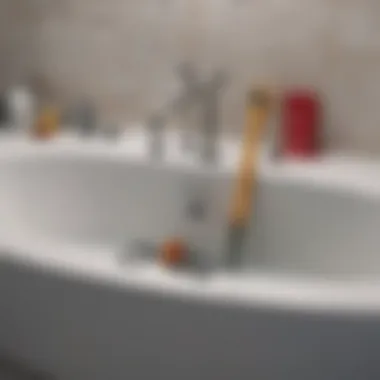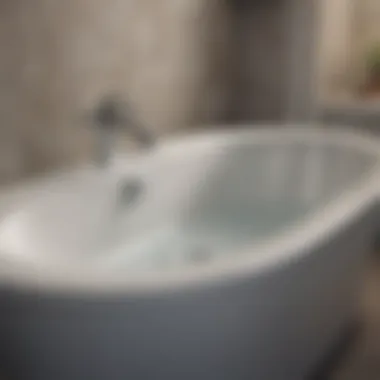Effective Methods to Unblock Bathtub Drains


Intro
Bathtub drains are often the unsung heroes of our home plumbing systems. While we rely on them every day for convenience and hygiene, they can also become a source of frustration when clogged. Understanding how to effectively unblock a bathtub drain is crucial for homeowners and renters alike. This article aims to demystify the various methods, common causes of clogs, potential preventative measures, and when to seek the assistance of a professional plumber.
The significance of this topic cannot be overstated. A blocked drain can lead to unpleasant odors, water pooling, and even potential water damage to your living space. By acquiring the necessary knowledge, homeowners can tackle these plumbing issues head-on. The following sections will provide an in-depth look at effective techniques for unclogging bathtub drains, ensuring you have the skills needed for maintenance and repair.
Preamble to Bathtub Drain Issues
Understanding the importance of addressing bathtub drain issues is essential for maintaining a functional and hygienic home environment. Clogged drains can disrupt daily routines and lead to more significant plumbing problems if not resolved promptly. Acknowledge that even minor obstructions can escalate over time, resulting in costly repairs and potentially damaging the drainage system.
Bathtub drains typically face blockages from various sources, such as hair, soap scum, and accumulated debris. These factors can contribute to slow drainage and unpleasant odors. Addressing these issues not only provides immediate relief but also enhances the overall quality of home life.
Additionally, comprehending the nature of bathtub drain problems encourages homeowners and renters to adopt preventive measures. This can lead to a reduction in frequency of clogs, saving time and resources in the long run.
Consider this aspect when thinking about your plumbing system: proactive management is always preferable to reactive measures. With the right techniques and insight, individuals can maintain drain functionality, ensuring they are prepared to deal with any minor inconveniences before they evolve into larger issues.
In short, grasping the common causes and effective methods available for unblocking drains is a crucial step. It empowers residents to take charge of their plumbing issues, leading to more informed choices in both maintenance and repairs.
Common Causes of Bathtub Drain Blockages
Understanding the common causes of bathtub drain blockages is crucial for effective maintenance and timely resolution of plumbing issues. Recognizing these causes can help homeowners take proactive measures to prevent clogs. By comprehending these factors, one can reduce the frequency of blockages and save on potentially costly repairs. This section delves into significant culprits behind drain issues.
Hair Accumulation
Hair is one of the most prevalent reasons for bathtub drain blockages. When hair mixes with soap residue, it forms a dense mass that can easily trap other debris. This is particularly true in households with long hair. Clogging often occurs near the drain cover, making it difficult for water to flow.
To mitigate hair accumulation, consider installing a drain cover or hair catcher. Regular cleaning practices can also help reduce hair buildup. Removing visible hair after each use can be an effective habit to cultivate.
Soap Scum Buildup
Another significant contributor to drain clogs is soap scum. Soap contains fats and oils that can solidify over time, leading to a thick coating on the interior of pipes. This can restrict water flow and create an environment conducive to other blockages. Soap scum can adhere to hair and other debris, forming a larger obstruction.
Using liquid soap instead of bar soap can help minimize soap scum. Additionally, household cleaning products specifically designed to break down soap and grease can be effective. Regular pipe maintenance can also alleviate buildup.
Foreign Objects
Foreign objects can cause immediate blockages. Items such as toys, cotton swabs, or small personal items often end up in the drain. Once these objects enter the plumbing, they can create substantial obstacles. Even a small object can impede the flow of water significantly.
To prevent foreign objects from entering the drain, it is advisable to keep the bathtub area clear of small items. Educating family members about proper disposal methods for such objects can also help minimize risk.
Pipe Corrosion
Over time, pipes can corrode due to factors like mineral buildup and chemical reactions with materials within the plumbing system. Corrosion can lead to rough surfaces, making it easier for debris to accumulate and create blockages. This is typically an issue in older homes where plumbing infrastructure may be outdated.
Homeowners should periodically inspect pipes for signs of corrosion. Seeking professional plumbing assistance for older systems can be beneficial. Correcting pipe issues early may prevent more serious problems later.


Assessing the Severity of the Clog
Assessing the severity of a clog is crucial for formulating an effective solution. Recognizing how serious the blockage is can help you choose the right method to clear it. This assessment informs whether you need to use simple home remedies or call in a professional plumber.
Early Signs of Clogs
Early detection can save you from significant plumbing issues. Watch for signs like slow drainage or an unusual sound when draining water. Some common early signs include:
- Water pooling in the tub while draining.
- Gurgling noises from the drain.
- Unpleasant odors emerging from the drain.
These symptoms indicate that theres a blockage forming. Acting quickly on these symptoms reduces the risk of a complete drain failure. Understanding these signs can prevent more costly plumbing repairs in the future.
Testing Water Flow
Testing the water flow is a straightforward yet effective way to assess the clog's severity. You can do this by plugging the drain and filling the bathtub with a few inches of water. Once filled, remove the plug and observe:
- How fast the water drains.
- Whether the drainage is even or if it starts to back up.
If water drains slowly, there's likely a partial blockage somewhere in the system. A complete blockage is indicated if the water does not drain at all. This information is essential. It guides your next steps toward unclogging the drain effectively.
Remember: Regular monitoring of your bathtub's drainage can help catch problems early, saving you time and money.
Do-It-Yourself Unblocking Methods
Understanding the methods to unblock your bathtub drain is critical for any homeowner. Clogs can lead to persistent issues if not addressed promptly. Do-it-yourself methods provide practical solutions that can save time and money. They are usually straightforward, often requiring minimal equipment or supplies. By employing these techniques, you can maintain your plumbing's integrity without immediately calling a professional.
These methods not only empower you as a homeowner but they also often prevent minor issues from escalating into major problems. It is important to recognize these techniques' effectiveness while also understanding their limitations. Some clogs may require a more robust approach or professional intervention.
Plunger Technique
Using a plunger is a classic method in unclogging drains. The principle is straightforward: create pressure to force the blockage free. Start by filling your bathtub with a few inches of water. This water helps to create suction when you plunge. Ensure you cover the overflow drain with a wet cloth or use a standard sink plunger that fits snugly. Once set, provide firm, quick thrusts up and down, maintaining the seal. It may take several attempts, so be patient.
- Fill tub with water.
- Cover overflow with cloth.
- Place plunger over drain.
- Push and pull firmly.
If successful, the water should start draining normally again.
Use of Baking Soda and Vinegar
Baking soda and vinegar create a natural reaction that can dislodge debris in your pipes. First, pour one cup of baking soda down the drain. Follow this with one cup of vinegar. Leave the mixture for about 30 minutes. During this time, the chemical reaction can help break down grease and gunk. After the waiting period, flush the drain with hot water. This method is eco-friendly and safe for your plumbing.
- 1 cup baking soda
- 1 cup vinegar
- hot water
Snake Method for Deep Clogs
For more stubborn clogs, a plumbing snake can be an effective choice. A plumbing snake is a long, flexible tool designed to navigate through pipes. Insert the snake into the drain, twisting while pushing it through. This motion can dislodge or pull out the obstruction.
If you encounter resistance, keep turning the snake until it breaks through or the resistance eases. Once the clog is clear, run water to test for proper drainage.


Wet/Dry Vacuum Assistance
A wet/dry vacuum can be particularly effective for removing blockages. Start by creating a tight seal around the drain with the vacuum hose. Set the vacuum to the liquid setting, which will assist in drawing out the clog. If other methods have failed, this tool can extract both water and debris. Be cautious with the vacuum’s power, as some blockages may not be fully removable this way.
- Set vacuum to liquid.
- Seal hose at drain.
- Turn on vacuum to extract.
Utilizing these methods can provide an effective approach to managing minor bathtub clogs without professional assistance. Assess the situation carefully, and try these techniques before deciding if you need help from a plumber.
Chemical Drain Cleaners: Pros and Cons
Chemical drain cleaners present a rapid solution to unclog bathtub drains. Their availability and ease of use make them a common choice for many homeowners tackling stubborn blockages. However, understanding both the benefits and drawbacks of these products is crucial. It enables informed decision-making, ensuring a balance between efficacy and safety.
Rapid Clog Dissolution
Chemical drain cleaners work quickly to dissolve clogs. They typically contain powerful substances like sodium hydroxide or sulfuric acid。 The ingredients are designed to break down materials like hair, soap scum, and grease. When properly used, these cleaners can significantly reduce the time spent on drain maintenance. They can save homeowners from the need for more labor-intensive methods or professional help. Using a chemical cleaner might look like a straightforward choice, especially when immediate results are desired.
However, it is essential to note that effectiveness can vary based on the type and severity of the clog.
Potential Risks to Plumbing
Despite their benefits, chemical drain cleaners come with risks. One major concern is that they can corrode pipes over time. This risk is particularly pronounced with older plumbing systems, which may be more susceptible to damage. Chemical reactions can create heat, leading to deterioration of pipe materials such as PVC and metal.
In addition, improper use of these cleaners can lead to hazardous situations. For example, mixing different types of cleaners can produce harmful fumes or even cause explosions. It is also worth noting that these chemicals can negatively impact the environment. When disposed of improperly, they can contaminate water sources and harm wildlife.
Considerations
When choosing a chemical drain cleaner, consider the following factors:
- Type of clog: Some cleaners are tailored for specific materials.
- Pipe type: Be aware of the material composition of your plumbing system.
- Usage instructions: Always adhere to the manufacturer's directions.
- Environmental impact: Look for eco-friendly options if possible.
Chemical drain cleaners can be effective for quick fixes, but they are not without risks. Homeowners should weigh these considerations carefully before deciding on a cleaning method.
Preventive Measures to Avoid Future Clogs
Preventive measures to avoid future clogs are essential for maintaining a functional and efficient bathtub drain. Regular attention to this aspect can save homeowners considerable time and money. Clogs not only lead to inconvenient situations but may also cause potential damage to plumbing systems. Therefore, taking proactive steps can ensure that drains remain clear for long-term usage.
Regular Cleaning Practices
Establishing regular cleaning practices is crucial for preventing buildup in bathtub drains. This involves not just occasional cleanings but creating a consistent routine. One effective method is to clean the drain cover frequently. Hair and soap residues can accumulate quickly, so removing any visible debris on a weekly basis is advisable.
An additional step is to perform a deeper clean monthly. Combine hot water with a mixture of baking soda and vinegar. Pour the baking soda down the drain first, followed by the vinegar. This combination helps to break down minor blockages and keeps the pipes fresh. Ensure to flush the drain with plenty of hot water afterwards to wash away any remaining residue.
- Benefits of Regular Cleaning:
- Reduces the risk of serious clogs
- Maintains proper drainage
- Extends the lifespan of plumbing systems


By adhering to this cleaning schedule, bathtub drains can remain more functional and less prone to severe blockages.
Utilizing Drain Covers
Using drain covers is another important measure to avoid clogs. These simple devices act as barriers, catching debris before it can enter the drain. Hair, soap fragments, and other foreign objects can easily make their way into the plumbing if not intercepted by a cover.
Choosing a quality drain cover that fits snugly is key. There are various materials available, including plastic and stainless steel. Stainless steel covers tend to be more durable and can withstand frequent use and cleaning.
- Advantages of Using Drain Covers:
- Prevents large items from entering the drain
- Easy to clean and maintain
- Cost-effective solution to clog prevention
Proper usage of drain covers in conjunction with regular cleaning routines forms a robust defense against future clogs. Adoption of these preventive measures not only protects bathtub drains but also enhances overall household hygiene.
When to Call a Professional Plumber
In some cases, tub clogs can be more than just an annoyance. Understanding when to engage a professional plumber can prevent further damage and save costs. If your unblocking attempts yield no results or if simple techniques seem insufficient, it is wise to consult an expert.
Identifying Persistent Issues
There are several indicators that a blockage might be too severe for DIY methods. If consistent clogs occur despite regular maintenance and cleaning, this suggests a deeper issue in the plumbing system. Such persistent problems can point to:
- Tree root intrusion or extensive build-up within pipes.
- Structural issues such as misaligned pipes or damaged piping.
- Recurring issues that lead to frustration and wasted time.
Ignoring these conditions can lead to more significant plumbing failures or even damage to property. If symptoms are recurring, a plumber can conduct thorough inspections using specialized equipment like cameras to identify underlying problems.
Complex Drain Systems
Bathtub drain systems don't operate in isolation. They connect to a more complex network of plumbing that can include multiple fixtures. In cases where:
- Multiple drains are slow or blocked, this can indicate a main line problem affecting the entire system.
- Older homes may have obsolete plumbing materials that may need re-evaluation.
In such scenarios, professional plumbers bring expertise that goes beyond mere unclogging. They can assess the entirety of the drainage system, ensuring that solutions address not just the symptoms but the root causes as well.
In summary, while many blockages can be resolved independently, acknowledging the limitations of DIY efforts and knowing when to call in a professional can ensure the long-term health of your plumbing system.
Culmination and Summary of Best Practices
In summary, effectively managing bathtub drain issues is essential for any homeowner or renter. Addressing clogs promptly can prevent further damage and enhance your overall plumbing efficiency. This article has covered several crucial aspects to keep your drains clear and functioning well.
Key Elements Emphasized
- Understanding Causes: Recognizing the primary causes of blockages, such as hair accumulation and soap scum buildup, lays the foundation for effective maintenance.
- Timely Detection: Early identification of clogs can lead to simpler and more cost-effective solutions. Monitoring water flow and looking for warning signs can save time.
- DIY Methods: Familiarity with various unblocking techniques, like the use of plungers or baking soda and vinegar, provides homeowners with practical tools to address minor issues independently.
- Chemical Solutions: While chemical drain cleaners offer quick results, weighing their benefits against potential risks is crucial in maintaining the integrity of your plumbing system.
- Preventive Strategies: Regular cleaning and the use of drain covers are proactive measures that can significantly reduce the occurrence of future clogs.
- Professional Help: Understanding when to call in a professional plumber ensures that complex issues do not escalate into more significant problems.
Benefits of Implementing Best Practices
Following these guidelines helps in prolonging the life of your plumbing system. Consistent care not only improves efficiency but also enhances the comfort of your living space. It can reduce long-term costs associated with damages due to neglect. Furthermore, being proactive in drain care reflects responsible homeownership.
Final Consideration
By synthesizing the information outlined in this guide, you can navigate the complexities of bathtub drain maintenance with confidence. Whether you choose to tackle minor blockages yourself or engage a professional for more severe problems, knowledge is key.
"Prevention is better than cure." Regular upkeep will always outweigh the consequences of neglecting small plumbing issues.















